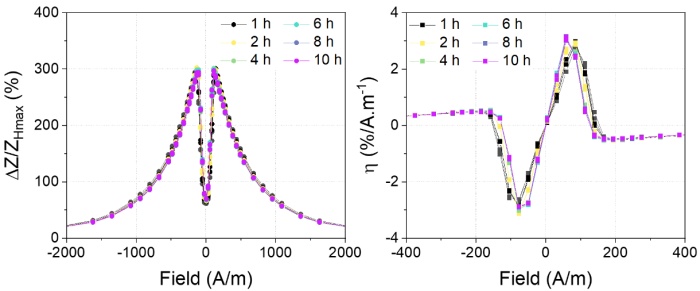Speaker
Description
Co-rich amorphous ribbons with nearly zero magnetostriction are well known for their outstanding giant magnetoimpedance (GMI) sensor characteristics [1,2]. However, their relatively low Currie temperature can be a disadvantage for their application at elevated temperatures. In this work, the effects of temperature on magnetoimpedance response were investigated in stress annealed commercial amorphous VITROVAC® 6025 I50 ribbons. As-quenched ribbons were subjected to tensile stress annealing at 700 MPa and 350$^\circ$C in order to induce transversal magnetic anisotropy, thereby enhancing the GMI sensitivity of the material. We utilized a specially designed set-up based on the impedance analyzer, which allowed us to measure the sample’s impedance up to 250$^\circ$C. Temperature stability of GMI during keeping the sample at 100$^\circ$C, 150$^\circ$C and 200$^\circ$C was monitored for different times up to 10 hours. For the sake of comparison, the GMI characteristics were also collected at room temperature after each high temperature measurement. The evaluated $\Delta Z/Z$ ratios and field sensitivities $\eta$ of GMI taken at 100 and 150 $^\circ$C showed only negligible changes during entire 10 hour time monitoring. On the other hand, a small continuous decrease of induced anisotropy field is observed after keeping the sample at 200$^\circ$C up to 4 hours (Fig. 1). Possible mechanisms behind the observed GMI changes as well as the application potential of stress annealed VITROVAC® 6025 amorphous ribbons for use in magnetic sensors at elevated temperatures will be briefly discussed.

Fig. 1 $\Delta Z/Z$ ratios and field sensitivities $\eta$ of VITROVAC® 6025 I50 measured at frequency 10 MHz after keeping the sample at 200$^\circ$C for different time.
Acknowledgements
This work was supported by the projects APVV-19-0369, VEGA 2/0148/23 and JRP NOMAGRAD. We thank Dr. G. Herzer and T. Strache from Vacuumschmelze GmbH for providing us with stress annealed samples.
References
[1] G. V. Kurlyandskaya, V. M. Prida, B. Hernando, J. D. Santos, M. L. Sánchez, and M. Tejedor, “GMI sensitive element based on commercial Vitrovac® amorphous ribbon,” Sensors and Actuators A: Physical, vol. 110, no. 1–3. Elsevier BV, pp. 228–231, Feb. 2004. doi: 10.1016/j.sna.2003.09.044.
[2] M.-H. Phan and H.-X. Peng, “Giant magnetoimpedance materials: Fundamentals and applications,” Progress in Materials Science, vol. 53, no. 2. Elsevier BV, pp. 323–420, Feb. 2008. doi: 10.1016/j.pmatsci.2007.05.003.

